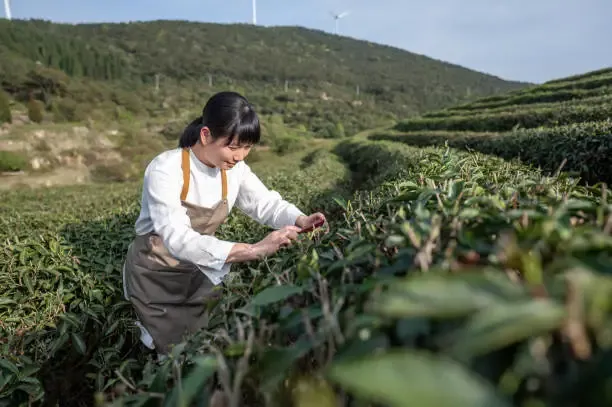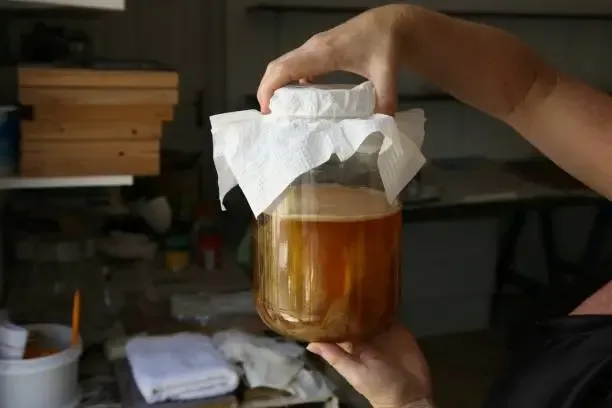In the heart of East Asia, a farming philosophy known as Korean Natural Farming (KNF) has been nurturing the land and its people. This method is more than just a way to grow crops; it’s a harmonious relationship between nature and farming.
The Roots of KNF The story of KNF begins with a man named Cho Han Kyu, who, after studying in Japan, returned to Korea and blended traditional Korean farming techniques with his newfound knowledge. His approach was simple yet revolutionary: use what nature provides and sustain it for future generations.
 |
| Photo Credit: Chun han |
What is Korean Natural Farming?
Korean Natural Farming (KNF) is a sustainable and eco-friendly approach to agriculture that emphasizes working with nature's processes rather than against them. It's a method that relies on the use of indigenous microorganisms (IMO), natural fertilizers, and herbal remedies to cultivate crops in a way that enhances soil health and biodiversity. KNF practitioners make their own inputs like Fermented Plant Juice (FPJ) and Fish Amino Acids (FAA) from local materials, which reduces reliance on commercial products and promotes a closed-loop system.
This farming technique not only aims to produce abundant and healthy crops but also to create a harmonious agricultural environment that supports the well-being of all its inhabitants, from the smallest soil organisms to the humans who tend the land and consume its bounty. KNF is more than just a set of farming practices; it's a philosophy that fosters respect for the intricate web of life and the natural cycles that sustain it.
The Essence of Korean Natural Farming (KNF)
Korean Natural Farming (KNF) isn't just about growing crops; it's a dance with nature. Imagine a farm where the soil hums with life, where plants thrive without chemicals, and where harmony reigns. Let's explore the heart of KNF:
Living Soil: KNF starts from the ground up—literally! Healthy soil is like a bustling city of microbes, earthworms, and fungi. KNF nourishes this living soil, ensuring it's rich in organic matter and nutrients.
Local Magic: Instead of shopping for fancy fertilizers, KNF farmers create their own. Fermented plant extracts (FPEs) and Indigenous Microorganisms (IMO) are the secret potions. These local brews boost soil health and plant vitality.
Nutrient Ballet: KNF follows the Nutritive Cycle Theory. It's like a choreographed dance. Fermented plant juices step in to enhance growth, while fish amino acids provide nitrogen. It's a symphony of nutrients playing out in the fields.
Why It Matters
- Sustainability: KNF reduces costs and environmental impact. No need for synthetic pesticides or herbicides.
- Safe Food: KNF-grown produce is free from harmful chemicals.
- Harmony: KNF respects the interconnectedness of all life—soil, plants, animals, and humans.
How to Making Fermented Plant Juice (FPJ)?
FPJ is like a magical potion for your plants. It’s an organic fertilizer made from plant material, especially young shoots from vigorously growing plants. Here’s how it works: We let these plant parts ferment with the help of molasses or brown sugar. The fermentation process extracts precious nutrients from the plant material. Think of it as turning plant goodness into liquid gold!
 |
| Photo Credit: Matthew de Lange |
1. Gather Your Ingredients:
- You'll need plant materials (think leaves, stems, or other green parts), brown sugar (or molasses), and water.
- Mix them in equal parts. For example, 1 kg of plant materials, 1 kg of brown sugar, and 1 gallon (around 3.8 liters) of water.
2. Mix and Dissolve:
- Put everything in a big, water-proof container.
- Stir until the sugar dissolves in the water. Imagine you're making a plant-friendly potion!
3. Cover and Wait:
- Cover the container with a cloth and secure it with a rubber band.
- Find a quiet, cool, and shaded spot (like your garage) for the container. Let it be undisturbed for about a week.
4. The Magic Happens:
- After a week, you'll notice molds growing on the surface. Don't panic—it's a good sign!
- The liquid will have a sweet-sour smell. That means beneficial bacteria have moved in.
5. Strain and Bottle:
- Mix the liquid thoroughly with a stick.
- Strain it into a large plastic bottle using a strainer. Leave some space for the bacteria to breathe.
- The leftover solid materials can go into your compost pile or the trash.
6. Let It Breathe:
- Loosely put the bottle cap on to allow air in.
- Store the bottle in a dark, protected area (like your garage).
7. Application:
- Dilute 1 cup of FPJ with 1 gallon of chemical-free water.
- Water your plants at their bases with this diluted liquid.
- Repeat once a week for most plants.
8. Strain and Store:
- Strain out the liquid (that’s your FPJ!). Store it in a cool place.
How to use?
- For Plants: Mix 2 tablespoons of FPJ with 1 liter of clean water. Spray it on leaves and trunks 1 to 2 times a week.
- For Animals: Mix FPJ with their drinking water (same dosage as above) twice a week.
FAQ
1. Can I use white sugar?
Ans. Yes, but brown or crude sugar is better—it gives nutrients to the helpful bacteria.
2. What are plant materials?
Ans. Think nitrogen-rich parts like pea, bean, lentil, soy, or peanut stems and leaves.
How you can adapt KNF Techniques to your farm?
KNF is a fascinating approach that emphasizes self-reliance, closed-loop systems, and the use of indigenous microorganisms to enhance soil and plant health. Here are some practical steps:
1. Start with Indigenous Microorganisms (IMOs): IMOs are beneficial microorganisms—like friendly bacteria and fungi—that you collect from your own farm. Instead of buying them in a bottle, you create your own. Here's how:
- Streamed Rice Box: Place steamed rice in a wooden box (cedar or bamboo works well) with small holes at the bottom. Cover it with a paper towel and secure it. Then place the box inside a cage to keep rodents out. This setup allows you to cultivate your own IMOs.
- Use IMOs: Once you have your IMOs, incorporate them into your farming practices. They'll help improve soil fertility and overall plant health.
2. Embrace Fermentation: KNF draws inspiration from Korean fermentation traditions. Fermented solutions play a crucial role:
- Fermented Plant Juice (FPJ): Made from plant material (like young shoots) and molasses or brown sugar. FPJ provides essential nutrients and growth hormones for your plants.
- Fish Amino Acids (FAA): Fermented fish scraps create a potent liquid fertilizer rich in amino acids.
- Lactic Acid Bacteria (LAB): Ferment rice wash or milk to create LAB. It enhances soil health and suppresses harmful pathogens.
3. Recycle Farm Waste:
- KNF encourages using waste products from your farm to generate fertility. Eggshells, compost, wild plants—these can all contribute to your soil's health.
- Composting: Explore innovative composting methods, like static aerated compost piles, which heat up without turning. This reduces reliance on external resources.
4. Chemical-Free Approach:
- KNF minimizes reliance on synthetic chemicals. Instead, it focuses on natural solutions.
- Liquid Fertilizers: These serve as chemical-free herbicides and pesticides. They protect plants from insects and diseases without harmful chemicals.
5. Learn and Experiment:
- Dive into KNF resources, including videos and guides. Chris Trump's YouTube videos are a great starting point.
- Observe and Adapt: Understand your farm's unique conditions. Experiment with KNF techniques and adjust them to suit your environment.
How does FPJ compare to chemical fertilizers?
When it comes to feeding our plants, we have choices. Let's explore how FPJ stacks up against those chemical fertilizers:
1. Ingredients:
- FPJ: It's like a garden salad—made from local plants and brown sugar. No chemicals, just nature's goodness.
- Chemical Fertilizers: These are like fast food for plants. They contain synthetic nutrients, often derived from non-renewable resources.
2. Nutrient Delivery:
- FPJ: It's a slow dance. FPJ releases nutrients gradually, nourishing plants over time.
- Chemical Fertilizers: They're the sprinters. Quick boost, but sometimes too much too soon.
3. Soil Health:
- FPJ: It's a soil party! FPJ enhances soil life, making it a cozy home for microbes.
- Chemical Fertilizers: They're like a one-night stand. They give nutrients but don't stick around to build relationships.
4. Environmental Impact:
- FPJ: Eco-friendly! It doesn't harm water bodies or wildlife.
- Chemical Fertilizers: They can be troublemakers—polluting water and disrupting ecosystems.
5. Cost:
- FPJ: Wallet-friendly. You make it at home with kitchen ingredients.
- Chemical Fertilizers: Pricey. Plus, they may need extra additives.
6. Plant Response:
- FPJ: Plants do a happy jig. They grow steadily and develop strong roots.
- Chemical Fertilizers: Sometimes they're like sugar highs—plants shoot up but crash later.
Conclusion
Korean Natural Farming (KNF) is a sustainable farming philosophy that emphasizes working with nature's processes and using indigenous microorganisms and natural fertilizers to enhance soil health and biodiversity. It aims to create a harmonious agricultural environment that supports the well-being of all living beings. The use of Fermented Plant Juice (FPJ) as an organic fertilizer is one of the techniques used in KNF, providing nutrients to plants in a slow and sustainable manner. KNF promotes sustainability, safe food production, and harmony in farming practices.
References & Resources
(1) An Introduction to Korean Natural Farming - Growing For Market https://www.growingformarket.com/articles/an-introduction-to-Korean-Natural-Farming
(2) Natural Farming 101: How To Get Started (KNF) - Sprouting Fam https://sproutingfam.com/natural-farming/
(3) Exploring the Essence of Korean Natural Farming (KNF): Harmony in Soil https://www.asiafarming.com/exploring-the-essence-of-korean-natural-farming-knf-harmony-in-soil-and-soul
(4) How to Make Fermented Plant Juice (Organic Fertilizer): 10 Steps - wikiHow https://www.wikihow.com/Make-Fermented-Plant-Juice-%28Organic-Fertilizer%29
(5) How To Make Organic Liquid Fertilizer, OHN Recipe - Sprouting Fam https://sproutingfam.com/organic-liquid-fertilizer/
(6) Fermented Plant Juice (FPJ) Organic Fertilizer Production Guide https://www.juanmagsasaka.com/2015/03/fermented-plant-juice-fpj-organic.html
(7) How To Make Fermented Plant Juice (FPJ) Liquid Fertilizer https://sproutingfam.com/fermented-plant-juice/
(8) What is the main benefit of using FPJ as a substitute for chemical https://typeset.io/questions/what-is-the-main-benefit-of-using-fpj-as-a-substitute-for-acmqlfda7b
(9) Fermented Plant Juice (FPJ) can spur plant growth https://agriculture.com.ph/2020/05/14/fermented-plant-juice-fpj-can-spur-plant-growth/

.png)



.jpg)

.jpg)
.jpg)



0 Comments